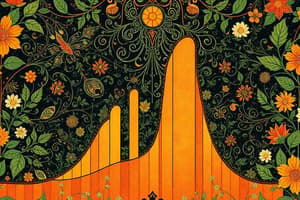Podcast
Questions and Answers
What information is required to calculate the variance for ungrouped data?
What information is required to calculate the variance for ungrouped data?
- Range and interquartile range
- Median and mode
- Mean and each individual number in the dataset (correct)
- Sum of all data points
In the variance formula for ungrouped data, what does $x_i$ represent?
In the variance formula for ungrouped data, what does $x_i$ represent?
- Sum of squared differences
- Total count minus one (n-1)
- The i-th datapoint (correct)
- Sample mean
Why do statisticians often use population variance instead of sample variance with large datasets?
Why do statisticians often use population variance instead of sample variance with large datasets?
- Population variance eliminates rounding errors that can affect large datasets (correct)
- Sample variance is more reliable for large datasets
- Population variance yields more accurate results
- Sample variance is too complex to calculate
What is the standard deviation of a dataset with a variance of 36?
What is the standard deviation of a dataset with a variance of 36?
How does standard deviation help in understanding a dataset?
How does standard deviation help in understanding a dataset?
If a dataset has a variance of $25$, how would you interpret this value?
If a dataset has a variance of $25$, how would you interpret this value?
What does a high variance indicate about the data points?
What does a high variance indicate about the data points?
How is standard deviation calculated in relation to the mean?
How is standard deviation calculated in relation to the mean?
What kind of distribution does a larger standard deviation imply?
What kind of distribution does a larger standard deviation imply?
How does low variance relate to the distribution of data points?
How does low variance relate to the distribution of data points?
Which measure helps determine if data points vary significantly from the mean?
Which measure helps determine if data points vary significantly from the mean?
How do you interpret variance and standard deviation based on central tendency measures?
How do you interpret variance and standard deviation based on central tendency measures?
Flashcards are hidden until you start studying
Study Notes
Variance and Standard Deviation for Ungrouped Data
Variance and standard deviation are fundamental statistical measures used to quantify how spread out or dispersed values of a variable are within a dataset. They help us understand if the numbers around the average value tend to be close together or far apart from it. In this context, we'll focus on these concepts when applied to ungrouped data, which is also known as raw data because it hasn't been grouped into categories yet.
Variance Calculation
The variance formula for ungrouped data requires two pieces of information: the mean (average) and each individual number in the set of data. It calculates the sum of squared differences between each data point and its corresponding mean, divided by the total count minus one (n-1):
[ \text{Var} = \frac{\sum_{i=1}^n(x_i - \overline{x})^2}{n-1} \ ]
Here, ( x_i ) represents the i-th datapoint, and ( \overline{x} ) represents the sample mean (average) of all the data points. When working with large datasets, variance can yield misleading results due to rounding errors, so statisticians often resort to using the population variance instead.
Standard Deviation Calculation
Standard deviation is simply the square root of variance. This makes sense when you consider what both statistics measure—the former gives us the average squared difference between the data points and their mean, while the latter provides the actual distance itself, calculated by taking the square root of the first statistic. The formula for standard deviation is:
[ \sigma = \sqrt{\frac{\sum_{i=1}^n(x_i - \overline{x})^2}{n}} \ ]
All calculations related to standard deviation involve computing differences and squaring them; only after obtaining the value do we take the square root once again to get back to the original scale of the data.
Interpreting Variance
A high variance signifies that there is more dispersion among the data points, meaning some values could be quite different from others. On the other hand, low variance indicates that most of the data points are concentrated near the average value. Knowing your variance helps you determine whether your data is clustered closely together or spread out further away from the mean.
Interpreting Standard Deviation
Standard deviation works similarly to variance. A larger standard deviation implies wider distribution or greater variability in the data, suggesting data points may vary significantly from the mean. Conversely, small standard deviation suggests the data lies closer to the average value. Essentially, you interpret variance and standard deviation based on how they compare against the central tendency measure—in this case, the mean of the dataset.
In summary, variance and standard deviation offer valuable insights into the degree of variation present in ungrouped data. By understanding these concepts and being able to calculate them accurately, you gain important tools for analyzing and visualizing patterns in various types of datasets.
Studying That Suits You
Use AI to generate personalized quizzes and flashcards to suit your learning preferences.



